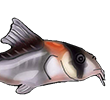Littmann, MW, MM Azpelicueta, JA Vanegas-Rios & JG Lundberg, 2015. Holotype-based validation, redescription and continental-scale range extension of the South American catfish species Hypophthalmus oremaculatus Nani and Fuster, 1947, with additional information on Hypophthalmus edentatus Spix and Agassiz, 1829 (Siluriformes, Pimelodidae). Proceedings of the Academy of Natural Sciences of Philadelphia 164: 159–176.
Abstract
The heretofore little-known pimelodid species Hypophthalmus oremaculatus Nani and Fuster, 1947, from the río Paraná, Argentina is redescribed and validated based on examination of its recently found holotype and extensive comparative study of specimens of all nominal species of the genus. Specimens of Hypophthalmus from the Paraná Basin have often been mistakenly labelled as H. edentatus Spix and Agassiz, 1829, and H. oremaculatus has occasionally been considered a junior synonym of H. edentatus. Examination of the syntypes of H. edentatus reveals a long-mistaken concept of its diagnostic features in the original description based on Spix's inaccurate illustration. Hypophthalmus oremaculatus is common and widespread in the Paraná Basin, including the Upper Paraná system. This species is also widespread in the Amazon and Orinoco basins.
Hypophthalmus oremaculatus is distinguished from other species of the genus by the following combination of characters: caudal fin shallowly-forked, head broad and short, membrane of skin tying the innermost pelvic-fin ray to the edge of the urogenital-anal region, 55–59 total vertebrae, 3–6 vertebrae with separate and robust neural spines between the Weberian complex and first vertebra with contact between its neural spine and a dorsal-fin pterygiophore, long mental barbels usually extending to pectoral origin or beyond, and dorsal-fin origin approximately in line with anal-fin origin.
Hypophthalmus oremaculatus
- Silurus
- Posts: 12463
- Joined: 31 Dec 2002, 11:35
- I've donated: $12.00!
- My articles: 55
- My images: 897
- My catfish: 1
- My cats species list: 90 (i:1, k:0)
- Spotted: 429
- Location 1: Singapore
- Location 2: Moderator Emeritus





